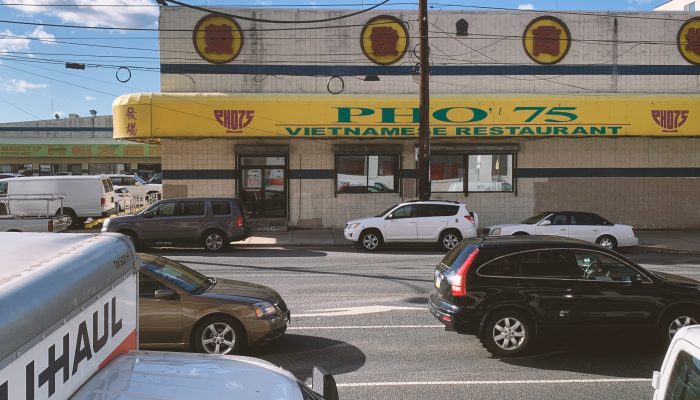Recently, the City’s Office of Transportation and Infrastructure Systems (oTIS) announced it had chosen the mixed lane option for Washington Avenue as its final final plan. It’s a good plan, albeit not as good as the original final plan.
When the City unveiled the final final plan on March 1, some expressed their disapproval of street safety improvements in general. Others were disappointed in the final plan reaching finality and being replaced by a less innovative design.
While not everyone agrees on which plan is ideal, we can agree that it’s confusing that the previous final plan is not the final plan and this final final plan is the final plan. We can also all agree that nobody wants Washington Avenue to stay the same as a dangerous, confusing, crater-ridden obstacle course.
Previously announced in September 2020 after five years of studies, evaluations, and analyses, the original plan was a three-lane configuration that maximized safety and speed reduction along Washington Avenue’s five-mile stretch bisecting South Philly. It would slow cars down and reduce the likelihood of people – drivers, pedestrians, bicyclists, kids, adults, youth, seniors, everyone – being killed or seriously hurt in crashes.
This kind of unnecessary tragedy is not a hypothetical, either. Out of 254 crashes between 2012 and 2018, four people died, including 83 year old Sarah Wood, 29 year old Sheena White, and 11-year-old Samantha Nguyen-Ortanez.
The redesign, then, was a case of government responding to tragedy in an effective, albeit long overdue manner. And it aligned perfectly with the concept of Vision Zero bringing us to zero crash related deaths, a key agenda item to Mayor Kenney’s successful election and reelection.
Everything seemed fine: the decision was based on sound engineering and a robust public engagement process involving dozens of online community surveys during the height of the quarantine when everyone was working remotely or home in general. This outreach yielded thousands of survey results that overwhelmingly supported the three lane option.
Except everything, apparently, wasn’t fine.
Some community members said they felt left out of the largely online public engagement effort. A few businesses said that the plan would jeopardize their operations. Cynics might say that there was a lack of political will to push back on any of this.
Despite the extensive outreach that had occurred, oTIS reopened the public engagement process – in a way. There was a small “working group” that formed in fall 2021 to log these newfound concerns.
In the end, the final plan reached its finality and oTIS torpedoed it in February 2022. Then, on March 1, 2022, they unveiled the new final final plan, a mixed lane plan featuring some of the old plan, to replace it.
First, here’s what’s good about the new mixed lane plan:
- 10 out of 22 blocks use the original plan’s three-lane configuration. It’s important to note that the only alternative offered is at least four lanes across the entire stretch of the avenue.
- 18 blocks of parking protected bike lanes that could be protected with concrete with future funding. There are currently no protected bike lanes on Washington.
- Leading pedestrian intervals letting those walking cross the street a few seconds before cars can proceed.
- Other speed and safety improvements, including some being used for the first time on a major Philly arterial like bus boarding islands, speed cushions on side streets and speed slots narrower on the avenue, hardened centerlines, and slow turn wedges at the corners.
- Automated red light camera enforcement.
Here’s what’s a problem and disappointing about the mixed lane plan:
- We lose 8 three-lane blocks of the three lane plan, which become four- or five-lane blocks instead.
- The five busiest blocks in the center of the corridor between 16th and 12th streets, which were always going to remain five-lane, have few traffic calming measures. The bike lane will be a painted five-foot one and only speed slots, which are like speed bumps but with cutouts for emergency response vehicles, function as calming measures.
- 17th Street doesn’t have the kind of safety features this major crossing for children, many of whom attend nearby Stanton Elementary, requires.
- The conflict at the shared bus pullover zone in the four-lane areas makes it more dangerous. It’s likely illegal parking will be problematic here, forcing bicyclists into the travel lane.
Short of reinstituting the original plan, the problems with the mixed lane plan are all easily mitigated by: filling the bike lane in with green paint from 16th to 12th as done on the Parkway, adding a six-foot-wide pedestrian refuge island in the middle of the crosswalk along with wider crosswalks set further back from the intersection at 17th Street, and moving the bus stop to the other side of the
One glaring overall issue that the original plan addresses is the length of crossing the street. While the mixed lane plan addresses it in points, it’s still concerning for seniors and children along most of the route.
The curious demise of the three-lane option was frustrating for many reasons, not the least of which is that Washington Avenue is on the High Injury Network and particularly dangerous because a person walking or biking on Washington Avenue is much more likely to be hit than on other Philadelphia streets. It deserved the safest option possible.
There are real issues that opponents of the original plan expressed, namely the reality of inequitable access to information and community input opportunities in general, years of racist and classist disinvestment or no investment at all in certain neighborhoods, and an overall lack of trust in agency officials, their data, and their conclusions based upon a variety of factors including the racism of many past urban renewal projects in general.
We as a city and nation have a long way to go on addressing historical abuses that fuel current, and frankly righteous, outrage as neighborhoods change and gentrification and America’s housing crunch together jeopardize so many. It’s wrong to be dismissive of these concerns when sincere.
Clearly, these issues are worth addressing and remedying overall, both locally and across the nation. Whether these issues should be the rationale for not saving as many lives as possible when given that opportunity is less clear.
This isn’t the first time that a Vision Zero or traffic safety project that prioritizes pedestrians or bicyclists has hit the buzzsaw of hyper local or even national politics, though. And it probably won’t be the last.
Locally, all too frequently, projects get watered down to make them acceptable to neighborhood civic associations like RCOs or blocks of neighbors.
Philadelphia’s car culture and the standard operating procedure of deferring to the position of near neighbors, especially those near neighbors who are politically connected, remain significant hurdles.
In this case, the chosen mixed lane option is a compromise with pros and cons. The planning process is a microcosm of large, structural issues at play whether people want to acknowledge that or not, too.
Whether we let these issues affect how many lives we save and prevent from being killed in crashes is entirely on us and those we entrust with decisionmaking. Now more than ever, Mayor Kenney and councilmembers Johnson and Squilla must prioritize safety.
In the end, the mixed lane plan isn’t just better than nothing, though that’s true too. It does dramatically improve safety. So, let’s get on with making Washington Avenue safer for all already.
Sarah Clark Stuart is the Executive Director of the Bicycle Coalition of Greater Philadelphia. She can be reached at sarah@bicyclecoalition.org.




